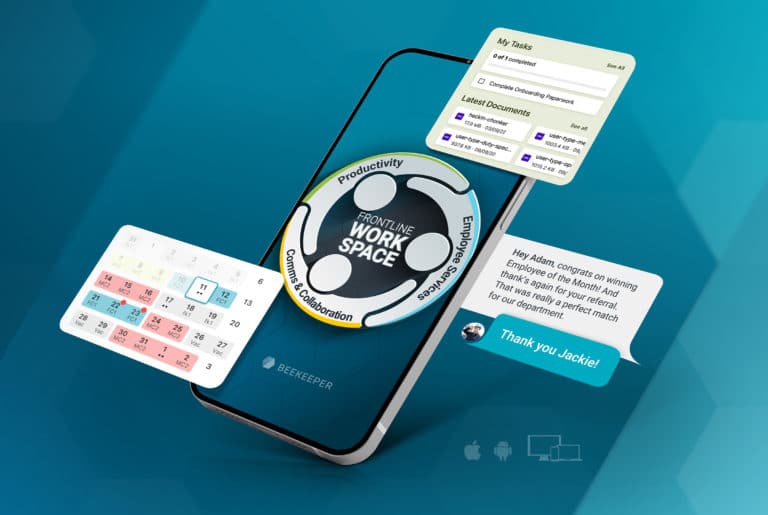7 Labor Shortage Solutions That Give You Real Results

Labor shortages usually happen when there simply aren’t enough workers to fill jobs. But the current labor shortage facing the United States is different. There are plenty of workers. There are enough people to fill jobs. But there aren’t enough jobs that people want.
This shortage of employees has shifted the balance. We are living through a time of virtually unprecedented labor power, especially in frontline-majority industries. In this climate, businesses need tech-driven labor shortage solutions. With the right technology, business leaders can retain and recruit like never before.
Retain and Recruit: Reduce Your Shortage of Employees
Let’s take a look at the shortage of employees with recent labor statistics. According to the US Chamber of Commerce:
- In March 2023, there were 1.8 million more vacant jobs than in February 2020
- The current workforce participation rate is only 62.6%
- For every 100 open jobs, there are only 68 workers
Staffing problems compound each other. Our Frontline Trends 2023 report showed that 90% of frontline workers rate proper staffing as crucial for their happiness. More than 1 in 3 say that inadequate staffing is their #1 stressor at work.
Understaffed teams contribute to an unhappy workforce. Unhappy workers are more stressed and more likely to quit.
Business leaders need to do two things: retain the workers they have and recruit workers to fill gaps in shift coverage.
The best ways to make this happen include:
- Ensuring proper staffing
- Communicating the broad vision and all the important details
- Providing context around policy changes and big decisions
- Having more reliable and predictable shift schedules
- Boosting engagement, communication, and connection
- Creating a safer, more rewarding work culture
While none of this comes from flipping a switch, leaders don’t have to overhaul everything. There are tech-driven solutions to help you implement smart changes that make a real difference.
7 Labor Shortage Solutions
The best labor shortage solutions not only help businesses reach the right workers in this tumultuous labor market and find the ideal candidates to solve the shortage of employees while ensuring employees feel like valued members of the team at all stages of their careers.
1. Recruiting: More Referrals = Better Employees
There are a lot of ways to find qualified candidates, but none are more effective than a referral program. Referrals help businesses tap into employee networks and connect with candidates who would otherwise not have been on their radar. That includes those who aren’t actively looking for a new job but are open to the right opportunity. Referrals also tend to be faster to hire and stay with companies longer.
One way to boost referral programs is to make it easy for employees to understand the rules, offer meaningful rewards, and streamline the referral process. An operating system for frontline-majority businesses that centralizes communication with frontline teams makes that possible.
2. Optimize the Onboarding Experience
The onboarding experience is where you make your first real impression on new hires. They want an easy and quick entry into their job without a lot of tedious paperwork.
Research has shown that employees with a negative onboarding experience were twice as likely to look for a new job in the near future. At a time when labor is already scarce, that can have serious consequences.
A well-orchestrated onboarding process is built on the following principles:
- Automate. Make it easier for HR professionals to manage paperwork so they can spend more personal time with new hires.
- Centralize. A central, digital place where employees can easily find orientation and training material simplifies onboarding, improves efficiency, and ensures new team members have what they need to succeed.
- Go mobile. Digitize paperwork and create on-the-go learning programs that employees can access anywhere, anytime.
3. Make Training an Ongoing Process
It’s not just new hires who need training. Processes and policies are constantly being updated. Technology is advancing. New products are rolled out, and new goals are always in sight. All employees need a way to access the information they need to stay ahead of changes.
Ongoing training and access to training materials help employees stay engaged, informed, and confident in their roles, even as those roles change. It also shows that businesses are investing in employees and supporting their professional development. That can be a powerful way to keep employees on board.
4. Provide Context Around Why Policies and Processes Change
In business, change is good. Improving processes, expanding product offerings, and adjusting goals are all vital to staying at the top of the game. The problem is that these decisions are made by executives, and the logic behind changes often doesn’t trickle down to frontline employees. That can create problems and fuel the disconnect with their frontline teams.
86% of employees say that context for change is important to their workplace happiness. Businesses that don’t contextualize change risk damaging morale and compromising relationships with workers.
When organizational changes are on the horizon, managers should clearly communicate:
- What changes are being made
- Why they are being made
- Where changes fit into the big picture
- How employees will be affected
When employees understand why they are doing the work they are doing, they feel more engaged and motivated. They feel part of something. That can go a long way toward delivering higher retention.
5. Better Scheduling for Better Lives
A few years ago, many frontline workplaces wouldn’t even have considered flexible scheduling. Today, that’s changed. Workers want flexibility, and being able to offer it is invaluable for businesses looking for labor shortage solutions.

Flexible scheduling gives employees more control over their lives and more opportunities to establish a happy balance. Of course, that doesn’t mean there should be a free-for-all. Advanced shift scheduling software allows businesses to maintain adequate staffing while offering greater flexibility.
6. Build Better Teams Through Better Communication
80% of workers are frontline employees. Yet, many frontline employees are isolated from the larger organizations they work for. That can make it hard to stay connected to company goals, or even know what those goals are. Without feeling like part of a team or understanding their role in the bigger picture, it’s easy to become demotivated. That makes it easy to leave.
Technology can change that.
A mobile-first operating system that lets frontline employees communicate and collaborate with each other across the organization opens up new opportunities for engagement. Whether it’s sharing tips, brainstorming new ideas, or just getting to know each other, offering ways to connect is one of the best labor shortage solutions.
It’s about more than immediate problem-solving. It’s about building strong teams, making sure everyone feels included, and encouraging them to make their voices heard.
7. Recognize and Reward
Recognition has a direct impact on employee engagement. Lack of recognition is one of the top reasons people leave their jobs. It makes sense: everyone wants to be seen, and everyone wants to know that their work is valued. That’s why a robust recognition program is key to employee retention.
The best recognition programs have two components:
- Tangible rewards, monetary and otherwise
- Peer and management recognition
Don’t underestimate the second part. While a nice bonus is always appreciated, it is just as valuable for an employee to have a work environment where they know that their peers and higher-ups see and appreciate their efforts. An operating system for frontline businesses is a great place to recognize employees and ensures that recognition is seen by everyone in the organization.
Beekeeper: The Best Way to Recruit and Retain
Higher quality referrals. More connection and better engagement. Empowering employees to do their jobs in a more productive, rewarding, and fulfilling way. Those are real labor shortage solutions. That’s what Beekeeper can do.

Beekeeper’s innovative operating system for frontline businesses is a powerful platform for recruiting new employees, and creating workplaces where employees want to stay, and is a key strategy for labor shortage solutions. Our end-to-end, multilingual software helps business leaders implement the strategies they need to strengthen their workforces and support employees throughout their careers. Ultimately, we help you become the business you want to be.
With Beekeeper, you can implement meaningful labor shortage solutions that help your business thrive. Talk to one of our experts to learn more about what we can do for you.
Most Frequently Asked Questions
How can the shortage of labor be overcome?
- Recruiting: More Referrals = Better Employees
- Optimize the Onboarding Experience
- Make Training an Ongoing Process
- Provide Context Around Why Policies and Processes Change
- Better Scheduling for Better Lives
- Build Better Teams Through Better Communication
- Recognize and Reward
Why are labor shortage solutions important?
The best labor shortage solutions not only help businesses reach the right workers, but ensure employees feel like valued members of the team at all stages of their careers.

About the author
Beekeeper
We make frontline lives easier, work safer, and teams more connected so businesses can reach new heights. At Beekeeper, we’re dedicated to making frontline lives easier by connecting workers with the tools, support, and information they need to feel valued, do their best work, and drive the business forward.







